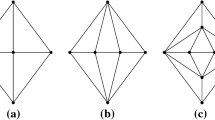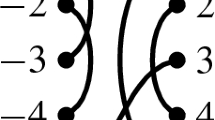Abstract
In previous work, joint with Bux, Fluch, Marschler and Witzel, we proved that the braided Thompson groups are of type \({{\,\mathrm{F}\,}}_\infty \). The proof utilized certain contractible cube complexes, which in this paper we prove are \({{\,\mathrm{CAT}\,}}(0)\). We then use this fact to compute the geometric invariants \(\Sigma ^m(F_{{\text {br}}})\) of the pure braided Thompson group \(F_{{\text {br}}}\). Only the first invariant \(\Sigma ^1(F_{{\text {br}}})\) was previously known. A consequence of our computation is that as soon as a subgroup of \(F_{{\text {br}}}\) containing the commutator subgroup \([F_{{\text {br}}},F_{{\text {br}}}]\) is finitely presented, it is automatically of type \({{\,\mathrm{F}\,}}_\infty \).



Similar content being viewed by others
Notes
The notation BG often stands for a classifying space of a group G, so even though there is not actually any risk of confusion we will stick to writing \(V_{{\text {br}}}\) and \(F_{{\text {br}}}\) instead of BV and BF.
References
Bestvina, M., Brady, N.: Morse theory and finiteness properties of groups. Invent. Math. 129(3), 445–470 (1997)
Bieri, R., Renz, B.: Valuations on free resolutions and higher geometric invariants of groups. Comment. Math. Helv. 63(3), 464–497 (1988)
Bieri, R., Neumann, W.D., Strebel, R.: A geometric invariant of discrete groups. Invent. Math. 90(3), 451–477 (1987)
Bieri, R., Geoghegan, R., Kochloukova, D.H.: The sigma invariants of Thompson’s group \(F\). Groups Geom. Dyn. 4(2), 263–273 (2010)
Brady, T., Burillo, J., Cleary, S., Stein, M.: Pure braid subgroups of braided Thompson’s groups. Publ. Mat. 52(1), 57–89 (2008)
Bridson, M.R., Haefliger, A.: Metric spaces of non-positive curvature. Grundlehren der Mathematischen Wissenschaften [Fundamental Principles of Mathematical Sciences], vol. 319. Springer, Berlin (1999)
Brin, M.G.: The algebra of strand splitting. II. A presentation for the braid group on one strand. Internat. J. Algebra Comput. 16(1), 203–219 (2006)
Brin, M.G.: The algebra of strand splitting. I. A braided version of Thompson’s group \(V\). J. Group Theory 10(6), 757–788 (2007)
Burillo, J., Cleary, S.: Metric properties of braided Thompson’s groups. Indiana Univ. Math. J. 58(2), 605–615 (2009)
Bux, K.-U.: Finiteness properties of soluble arithmetic groups over global function fields. Geom. Topol. 8, 611–644 (2004)
Bux, K.-U., Gonzalez, C.: The Bestvina-Brady construction revisited: geometric computation of \(\Sigma \)-invariants for right-angled Artin groups. J. London Math. Soc. (2) 60(3), 793–801 (1999)
Bux, K.-U., Fluch, M.G., Marschler, M., Witzel, S., Zaremsky, M.C.B.: The braided Thompson’s groups are of type \({\rm F_\infty } \). J. Reine Angew. Math. 718, 59–101 (2016). (With an appendix by Zaremsky.)
Dehornoy, P.: The group of parenthesized braids. Adv. Math. 205(2), 354–409 (2006)
Farb, B., Margalit, D.: A primer on mapping class groups. Princeton Mathematical Series, vol. 49. Princeton University Press, Princeton (2012)
Farley, D.S.: Finiteness and \({\rm CAT(0)}\) properties of diagram groups. Topology 42(5), 1065–1082 (2003)
Geoghegan, R., Mihalik, M.L., Sapir, M., Wise, D.T.: Ascending HNN extensions of finitely generated free groups are Hopfian. Bull. Lond. Math. Soc. 33(3), 292–298 (2001)
Gromov M.: Hyperbolic groups. In: Essays in group theory, vol 8 of Math. Sci. Res. Inst. Publ., pages 75–263. Springer, New York (1987)
Haglund, F.: Finite index subgroups of graph products. Geom. Dedicata 135, 167–209 (2008)
Kenneth S.B.: Finiteness properties of groups. In: Proceedings of the Northwestern conference on cohomology of groups (Evanston, Ill., 1985), vol 44, pp 45–75 (1987)
Koban, N., McCammond, J., Meier, J.: The BNS-invariant for the pure braid groups. Groups Geom. Dyn. 9(3), 665–682 (2015)
Leary, I.J.: A metric Kan–Thurston theorem. J. Topol. 6(1), 251–284 (2013)
Lodha, Y., Moore, J.T.: A nonamenable finitely presented group of piecewise projective homeomorphisms. Groups Geom. Dyn. 10(1), 177–200 (2016)
Meier, J., Meinert, H., VanWyk, L.: Higher generation subgroup sets and the \(\Sigma \)-invariants of graph groups. Comment. Math. Helv. 73(1), 22–44 (1998)
Meier, J., Meinert, H., VanWyk, L.: On the \(\Sigma \)-invariants of Artin groups. Topology Appl. 110(1), 71–81 (2001). (Geometric topology and geometric group theory (Milwaukee, WI, 1997))
Meinert, H.: Actions on \(2\)-complexes and the homotopical invariant \(\Sigma ^2\) of a group. J. Pure Appl. Algebra 119(3), 297–317 (1997)
Quillen, D.: Homotopy properties of the poset of nontrivial \(p\)-subgroups of a group. Adv. Math. 28(2), 101–128 (1978)
Stefan, W., Matthew, C.B.Z.: The \(\Sigma \)-invariants of Thompson’s group \(F\) via Morse theory. In: Topological methods in group theory, volume 451 of London Math. Soc. Lecture Note Ser., pages 173–193. Cambridge Univ. Press, Cambridge (2018)
Stein, M.: Groups of piecewise linear homeomorphisms. Trans. Am. Math. Soc. 332(2), 477–514 (1992)
Zaremsky, M.C.B.: HNN decompositions of the Lodha-Moore groups, and topological applications. J. Topol. Anal. 8(4), 627–653 (2016)
Zaremsky, M.C.B.: Separation in the BNSR-invariants of the pure braid groups. Publ. Mat. 61(2), 337–362 (2017)
Zaremsky, M.C.B.: On the \(\Sigma \)-invariants of generalized Thompson groups and Houghton groups. Int. Math. Res. Not. IMRN 19, 5861–5896 (2017)
Zaremsky, M.C.B.: On normal subgroups of the braided Thompson groups. Groups Geom. Dyn. 12(1), 65–92 (2018)
Acknowledgements
Thanks are due to Javier Aramayona and Rodrigo de Pool for catching a mistake in a previous version of this paper.
Author information
Authors and Affiliations
Corresponding author
Additional information
Publisher's Note
Springer Nature remains neutral with regard to jurisdictional claims in published maps and institutional affiliations.
Rights and permissions
About this article
Cite this article
Zaremsky, M.C.B. Geometric structures related to the braided Thompson groups. Math. Z. 300, 2591–2610 (2022). https://doi.org/10.1007/s00209-021-02866-9
Received:
Accepted:
Published:
Issue Date:
DOI: https://doi.org/10.1007/s00209-021-02866-9




